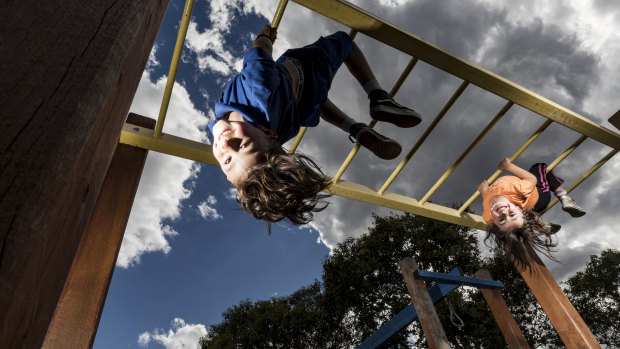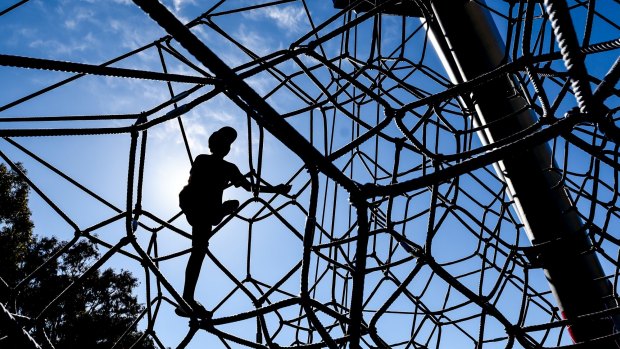This was published 6 years ago
No more monkeying around: Push to remove dangerous play equipment
A quiet war is being waged in parks and primary schools across Australia against a once beloved piece of play equipment.
Proponents say they encourage children to play outside in an age dominated by screens and video games, build upper body strength, balance, risk management and resilience. But those who want to see them replaced say they are among the leading causes of childhood accidents and can lead to traumatic injuries.

Arlo (8) and Mina (4) love the monkey bars at their local park in Footscray. Credit: Chris Hopkins
They may be one of the least flashy bits of hardware on the playground, but the reputation of the humble monkey bars is under siege.
Lisa Sharwood, an injury epidemiologist at the University of Sydney, said despite playground safety standards improving, monkey bar injuries were on the rise in Victoria.
Dr Sharwood has worked with Monash University’s Victorian Injury Surveillance Unit on research to be published in coming months which found a 41 per cent increase in emergency department presentations in Victoria as a result of monkey bar injuries over the past decade.
"There were a total of 14,167 monkey bar related Emergency Department presentations – with 81 per cent in the five to nine-year-old age group," she said.
"There have been 6430 hospital admissions over this same time period as a result of the injuries sustained on monkey bars. Most of these will be fractures – upper limb and ankle, and many will have required surgery."
Another expert is is leading the charge for an end to the age of the monkey bar.
David Eager, professor of risk management at the University of Technology Sydney, has chaired Standards Australia's playground equipment and surfacing committee for a decade.
Professor Eager is a man with considered opinions on monkey bars – and decades of research to back those opinions up.
"They are, if not the most dangerous, they are up there in the top contributors to injuries," he said.
Professor Eager does not want to see risk removed from playgrounds. On the contrary, he thinks exposing children to risk is vital in raising well-balanced and happy kids. But monkey bars, he said, are a hazard.
"Monkey bars were OK when I was a kid 60 years ago, but they’re not an appropriate form of play equipment in 2018," Professor Eager said.
The playground guru wants monkey bars replaced with space nets, the 3D rope structures which have been popping up in playgrounds like spider webs.
For decades, people such as Professor Eager have waged war against the monkey bars of yore: the old school ones which soared metres above bone-breaking concrete, wide gaps yawning between metal bars, often baking in the sun.
The Standards Australia's committee sets the standards, which have seen monkey bars become lower to the ground, more compact, the surface beneath them softer (bark mulch more than 40 centimetres thick is recommended).

Playground safety advocates say space nets better hold large numbers and break the fall of children who come off them.Credit: Peter Hardin
But in recent years his committee has been advocating space nets, which break children's falls, rather than monkey bars, which don't. Professor Eager said where monkey bars had been replaced, injury rates had fallen.
"Most councils and schools have been pulling [monkey bars] out and replacing them with spatial nets ... [but] not as quickly as we'd like," he said.
All the while, playgrounds have been sending a steady stream of injured children to the doctors.
On Thursday, Macquarie University Associate Professor Rebecca Mitchell addressed a National Kidsafe symposium in Sydney on the "orthopaedic trauma of playground falls".
The centre for Healthcare Resilience and Implementation researcher's findings came from a 10-year analysis of childhood hospitalisation in Australia.
In the decade up to 2012, 56,723 children went to hospital after a playground fall. Of those, 80 per cent were considered minor injuries, such as fractured arms, 17 per cent moderate (such as fractured femur) and 2 per cent were serious injuries, such as brain trauma.
Boys were only slightly more likely to be injured (54 per cent) and the most injury-prone age bracket were the 6 to 10 year olds.
Trampolines and "playground climbing apparatus" each accounted for about one third of those trips to the hospital.
"Falls are one of the biggest causes of hospitalisation for children ... then road transport," Ms Mitchell said.
"Of the falls, falls from playground equipment are the most common."
While there is no specific data on monkey bars, her work names and shames "horizontal climbing equipment".
But at least one person who broke their arm on a monkey bar does not blame the equipment.
"I've been a victim of the monkey bars!," Parents Victoria executive officer Gail McHardy said.
"But that wasn't the monkey bars fault, that was because of another little boy ... I remember his name well."
Ms McHardy doesn't want to see monkey bars go, she said children needed to have the opportunity to ramble, climb and take risks in a controlled environment.
Which is where everyone agrees. It's just Professor Eager thinks "nets do it much much better".
"Monkey bars are just so popular at lunchtime and recess kids are fighting for them, jostling for position – it’s one of the contributing factors to injuries," he said.
"Spatial nets get 50 odd kids on them and still seem to be saying, ‘Have you got any more you can give me?’"
So while children will keep on climbing, the humble monkey bar may soon join the see-saw and the metal merry-go-round in the playground history books, while play equipment enters the space net age.